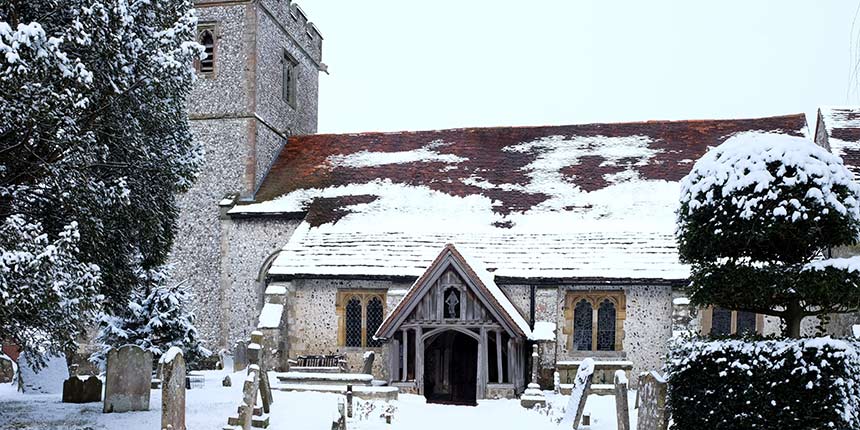Safe use of church heating systems
The average Anglican church is a tricky place to heat. This guidance provides advice on the safe and efficient use of various church heating systems.
Cold weather can cause problems for churches and associated properties. This risk guidance gives practical advice for common issues.

Just a small fracture in a pipe can release gallons of water, damaging masonry and plaster, carpets and other contents.
The chance of suffering these losses can be reduced by following a few simple steps:
If you find a frozen pipe, don’t wait for it to burst. Turn off your water supply and then slowly thaw the affected pipe by introducing gentle heat to the area, for example, using a hairdryer, space heater or hot water bottle. Do not attempt to thaw the pipe with a blow torch or other open flame.
If the worst happens and you have a burst pipe, turn off the water supply at the stopcock and try to catch any excess water in a bucket or other container. Do not use any electrics if you believe they may have been affected by the escaping water. You will need to have these checked by a professional electrician.
Autumn brings fallen leaves that fill gutters. Those gutters have downpipes which only work if they are clear of obstruction. If they are not maintained, blockages will occur and the build-up of water will eventually cause damage. Additionally, if there is a blockage in a downpipe, any trapped rainwater may crack or shatter the downpipe if it freezes.
Remember to add to your list of jobs checking your valleys, gutters, hoppers and downpipes for blockages so that they can carry water away quickly and efficiently. Signs of soil being washed away at ground level or splashes of soil at the base of walls can show that water is not being caught by the gutter.
If blockages are identified, arrange for a local contractor who can work safely at height to clear the problem.
You have a duty of care to ensure that any visitors are safe.
Unfortunately, slips and trips can happen, particularly when there is ice and snow on the ground. You should take actions that are ‘reasonable in the circumstances’. This can include ensuring that entry and exit routes are kept free of anything which may cause a person to slip and taking preventative measures, such as clearing and gritting paths.
It is not necessary to ensure that each and every available path is immediately cleared, as long as there is one safe route available to access the building.
Clearly, the timing and extent of any snow fall is relevant. While it might not be reasonable for paths to be cleared during heavy falls of snow, the longer the snow and ice remain on the ground after the fall has ceased, the greater the likelihood of it being considered reasonable for some attempt to be made to clear it.
Should your main church heating system fail during the winter months, we recommend that electric convector or fan-assisted heaters with thermostatic cut-outs (that operate in the event of over-heating) are used as a temporary measure.
Liquid petroleum gas (LPG) heaters give off lots of water vapour which can have an adverse effect on the building, and can lead to the onset of rot in woodwork. If they are used, cylinders should be kept to a minimum and preferably changed in the open air in a well ventilated area away from any source of ignition.
Electric radiant heaters and paraffin/oil fired heaters should never be used, even as a temporary measure.
Portable heaters should be sited well clear of woodwork or other combustible materials, and where possible, protected against the possibility of being knocked over or moved accidentally by the fitting of guards.
Temporary heaters should not be left unattended for long periods or used when the building is unoccupied, and should never be moved once they have been switched on.
Please be aware this advice is provided to you as best practice guidance from Ecclesiastical. Please check your policy documents for details of any conditions specific to your policy.